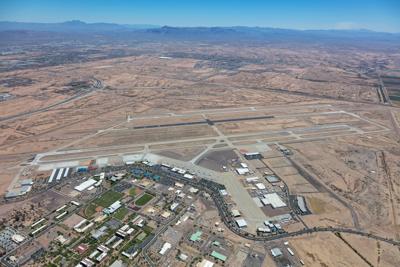Having an airport in your backyard can be somewhat noisy. But it can also mean more convenient flights and economic benefits to your community.
How does an airport grow its operations, while balancing the impact on those who live and work around it? Conversely, how does it protect itself from inevitable new development encroachment?
These are the concerns that Phoenix-Mesa Gateway Airport sought to address when it began updating its land-use plan. The current one was compiled in 2000.
Between 2000 and 2010, the airport planning area’s residential population burgeoned from 100,000 to 250,000, a jump of 150 percent. From 2010 to 2017, that population is estimated to have grown to 300,000.
“The goal is: How do we provide guidance to ensure not only orderly growth but compatible new development while we preserve the capacity and the potential of Gateway airport,” said Tony Bianchi, airport planner.
The plan took nearly two years to update and included conversations with stakeholders in Mesa, Gilbert and Queen Creek and unincorporated areas in Maricopa and Pinal counties.
The plan was capacity-based, Bianchi said, wherein the airport analyzed a reasonable capacity of the airport for the amount of operations (takeoffs and landings) it can handle.
The annual capacity was analyzed at a half-million. Current annual operations are at about a quarter-million.
“With the infrastructure that we already have in place now, we can accommodate almost twice as many operations,” Bianchi noted.
One of the key findings important to the airport’s neighboring communities is that the airport’s noise contours have actually reduced.
This is measured as the Day Night Average Sound Level, or DNL, which is the cumulative noise exposure as measured during an average annual day.
“When we did the noise modeling in 2000, what we found was it encompassed larger areas simply because we had much more military traffic,” Bianchi said. “As military traffic, while it’s still a presence, when it starts to decrease, and the aircraft get more quiet, more efficient, the sound footprint actually gets a little smaller.”
This means that some of the areas in Mesa, Gilbert and Queen Creek that had development restrictions because of the noise levels are now open for development.
“That was watched very intently by the communities and the development community,” he said.
The study also looked at the areas more prone to overflights, and found that most of Gilbert, and parts of Mesa and Queen Creek, are affected more than previously.

“About three-quarters of the airport’s traffic has what they call a northwest flow, so (airplanes) actually come in over Queen Creek and depart over Gilbert and Mesa,” Bianchi said.
The study considered data from weather patterns, wind patterns, radar tracks, noise complaint locations, development patterns and other factors to develop the new boundaries.
The changes in the overflight area are spurring the airport to make changes as well.
“If we were going to have more planes in the sky and we’re going to route them, we need to spread them out at certain busy times of the day,” Bianchi said. “If they’re running parallel to the runways, we need to expand these boundaries out.
“For property disclosure and for neighborhoods, we thought that it is in the airport’s best interest to disclose and say this is where we anticipate the growth to be, this is where we think the most overflights are going to occur and disclose that to the community,” he said.
The overflight areas have to be updated in the municipalities’ zoning departments.
The airport also has to disclose them through the Arizona Department of Real Estate, while the municipalities’ zoning departments have to update the land development code in their respective general plans.
The disclosures would only affect new housing development because homebuyers have to be notified.
“(Home sellers) are required to post signs, put notifications on plats, on mortgage papers that they are in an airport overflight area,” said Kyle Mieras, development services director of Gilbert, who was involved in the plan update process on the town’s behalf.
“It was a great process working with the airport, and they did a fantastic job of making sure everybody’s concerns were addressed,” Mieras said.
Ryan Smith, airport spokesman, said the airport’s goal is to be a good community steward.
“There are a lot of benefits that an airport brings, so we want to make sure that you’re successful, you’re protecting the neighborhoods and run a safe and efficient operation,” he said. “All of those go hand in hand, and the efforts are part of that.”
Smith said the airport was designed and built in 1942.
“It was done when there was nothing around here, and it was out in the middle of nowhere. It’s finding that happy medium as houses grow up and as people choose to locate near the airport,” he said.
– To read the 42-page Airport Land Use Compatibility Plan Update, visit gatewayairport.com/landusestudy.aspx. Comments may be sent to lucomments@gatewayairport.com.









